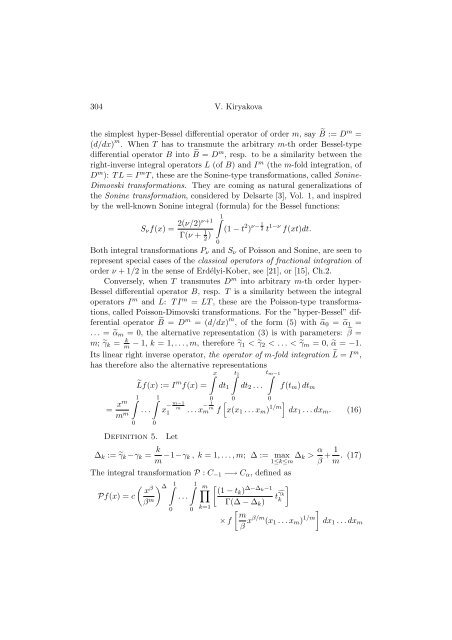VKiryakova_fcaa113
VKiryakova_fcaa113
VKiryakova_fcaa113
Create successful ePaper yourself
Turn your PDF publications into a flip-book with our unique Google optimized e-Paper software.
304 V. Kiryakovathe simplest hyper-Bessel differential operator of order m, say ˜B := D m =(d/dx) m . When T has to transmute the arbitrary m-th order Bessel-typedifferential operator B into ˜B = D m , resp. to be a similarity between theright-inverse integral operators L (of B) and I m (the m-fold integration, ofD m ): T L = I m T , these are the Sonine-type transformations, called Sonine-Dimovski transformations. They are coming as natural generalizations ofthe Sonine transformation, considered by Delsarte [3], Vol. 1, and inspiredby the well-known Sonine integral (formula) for the Bessel functions:∫1S ν f(x) = 2(ν/2)ν+1Γ(ν + 1 2 ) (1 − t 2 ) ν− 1 2 t 1−ν f(xt)dt.0Both integral transformations P ν and S ν of Poisson and Sonine, are seen torepresent special cases of the classical operators of fractional integration oforder ν + 1/2 in the sense of Erdélyi-Kober, see [21], or [15], Ch.2.Conversely, when T transmutes D m into arbitrary m-th order hyper-Bessel differential operator B, resp. T is a similarity between the integraloperators I m and L: T I m = LT , these are the Poisson-type transformations,called Poisson-Dimovski transformations. For the ”hyper-Bessel” differentialoperator ˜B = D m = (d/dx) m , of the form (5) with ˜α 0 = ˜α 1 =. . . = ˜α m = 0, the alternative representation (3) is with parameters: ˜β =m; ˜γ k = k m − 1, k = 1, . . . , m, therefore ˜γ 1 < ˜γ 2 < . . . < ˜γ m = 0, ˜α = −1.Its linear right inverse operator, the operator of m-fold integration ˜L = I m ,has therefore also the alternative representations∫ x ∫t 1 t∫m−1˜Lf(x) := I m f(x) = dt 1 dt 2 . . . f(t m ) dt m∫1= xmm m0∫ 1. . .0Definition 5.0x − m−1m1 . . . x − 1 mm fLet00[x(x 1 . . . x m ) 1/m] dx 1 . . . dx m . (16)∆ k := ˜γ k −γ k = k m −1−γ k , k = 1, . . . , m; ∆ := max1≤k≤m ∆ k > α β + 1 m . (17)The integral transformation P : C −1 −→ C α , defined as( ) xβ ∆ ∫1∫ 1 m∏[ (1 − tk ) ∆−∆ ]k−1Pf(x) = cβ m . . .tfγ kΓ(∆ − ∆ k )k0 0 k=1[ ]m× fβ xβ/m (x 1 . . . x m ) 1/m dx 1 . . . dx m





